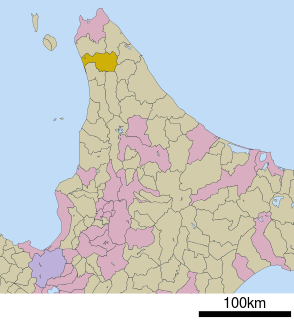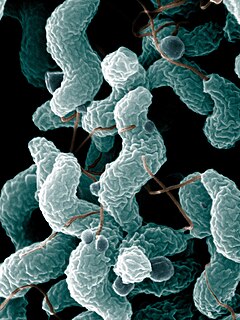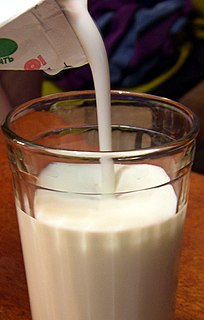
In bacteriology, gram-positive bacteria are bacteria that give a positive result in the Gram stain test, which is traditionally used to quickly classify bacteria into two broad categories according to their type of cell wall.

Yeasts are eukaryotic, single-celled microorganisms classified as members of the fungus kingdom. The first yeast originated hundreds of millions of years ago, and at least 1,500 species are currently recognized. They are estimated to constitute 1% of all described fungal species.
An anaerobic organism or anaerobe is any organism that does not require molecular oxygen for growth. It may react negatively or even die if free oxygen is present. In contrast, an aerobic organism (aerobe) is an organism that requires an oxygenated environment. Anaerobes may be unicellular or multicellular. Most fungi are obligate aerobes, requiring oxygen to survive. However, some species, such as the Chytridiomycota that reside in the rumen of cattle, are obligate anaerobes; for these species, anaerobic respiration is used because oxygen will disrupt their metabolism or kill them. Deep waters of the ocean are a common anoxic environment.
Methanogens are microorganisms that produce methane as a metabolic byproduct in hypoxic conditions. They are prokaryotic and belong to the domain Archaea. All known methanogens are members of the archaeal phylum Euryarchaeota. Methanogens are common in wetlands, where they are responsible for marsh gas, and in the digestive tracts of animals such as ruminants and many humans, where they are responsible for the methane content of belching in ruminants and flatulence in humans. In marine sediments, the biological production of methane, also termed methanogenesis, is generally confined to where sulfates are depleted, below the top layers. Moreover, methanogenic archaea populations play an indispensable role in anaerobic wastewater treatments. Others are extremophiles, found in environments such as hot springs and submarine hydrothermal vents as well as in the "solid" rock of Earth's crust, kilometers below the surface.

Horonobe-cho is a town located in Sōya Subprefecture, Hokkaido, Japan. There is a JR train station, Horonobe Station which connects Horonobe-town with other cities in Hokkaido.
The Microbiology Society is a learned society based in the United Kingdom with a worldwide membership based in universities, industry, hospitals, research institutes and schools. It is the largest learned microbiological society in Europe. Interests of its members include basic and applied aspects of viruses, prions, bacteria, rickettsiae, mycoplasma, fungi, algae and protozoa, and all other aspects of microbiology. Its headquarters is at 14–16 Meredith Street, London. The Society's current president is Prof. Judy Armitage. The Society is a member of the Science Council.
The International Code of Nomenclature of Prokaryotes (ICNP) formerly the International Code of Nomenclature of Bacteria (ICNB) or Bacteriological Code (BC) governs the scientific names for Bacteria and Archaea. It denotes the rules for naming taxa of bacteria, according to their relative rank. As such it is one of the nomenclature codes of biology.

Campylobacterota are a phylum of bacteria. All species of this phylum are Gram-negative.

Bacteria are ubiquitous, mostly free-living organisms often consisting of one biological cell. They constitute a large domain of prokaryotic microorganisms. Typically a few micrometres in length, bacteria were among the first life forms to appear on Earth, and are present in most of its habitats. Bacteria inhabit soil, water, acidic hot springs, radioactive waste, and the deep biosphere of Earth's crust. Bacteria are vital in many stages of the nutrient cycle by recycling nutrients such as the fixation of nitrogen from the atmosphere. The nutrient cycle includes the decomposition of dead bodies; bacteria are responsible for the putrefaction stage in this process. In the biological communities surrounding hydrothermal vents and cold seeps, extremophile bacteria provide the nutrients needed to sustain life by converting dissolved compounds, such as hydrogen sulphide and methane, to energy. Bacteria also live in symbiotic and parasitic relationships with plants and animals. Most bacteria have not been characterised and there are many species that cannot be grown in the laboratory. The study of bacteria is known as bacteriology, a branch of microbiology.

Medical microbiology, the large subset of microbiology that is applied to medicine, is a branch of medical science concerned with the prevention, diagnosis and treatment of infectious diseases. In addition, this field of science studies various clinical applications of microbes for the improvement of health. There are four kinds of microorganisms that cause infectious disease: bacteria, fungi, parasites and viruses, and one type of infectious protein called prion.
Methanogenium is a genus of archaeans in the family Methanomicrobiaceae. The type species is Methanogenium cariaci.
Methanoculleus is a genus of microbes within the family Methanomicrobiaceae. The species of the genus Methanoculleus live in marine environments brackish water, and are very common in bioreactors, landfills, and wastewater. Unlike other archaea, Methanoculleus and some species of related genera can use ethanol and some secondary alcohols as electron donors as they produce methane. This has implications as the production of methane as a greenhouse gas and consequences with respect to global climate change.

Archaea constitute a domain of single-celled organisms. These microorganisms lack cell nuclei and are therefore prokaryotes. Archaea were initially classified as bacteria, receiving the name archaebacteria, but this term has fallen out of use.

Microbiology is the scientific study of microorganisms, those being unicellular, multicellular, or acellular. Microbiology encompasses numerous sub-disciplines including virology, bacteriology, protistology, mycology, immunology, and parasitology.

Kefir is a fermented milk drink similar to a thin yogurt or ayran that is made from kefir grains, a specific type of mesophilic symbiotic culture. The drink originated in the North Caucasus, in particular the Elbrus region along the upper mountainous sections of Circassia, Karachay and Balkaria, from where it came to Russia, and from there it spread to Europe and the United States, where it is prepared by inoculating the milk of cows, goats, or sheep with kefir grains.

Holomycota or Nucletmycea are a basal Opisthokont clade as sister of the Holozoa. It consists of the Cristidiscoidea and the kingdom Fungi. The position of nucleariids, unicellular free-living phagotrophic amoebae, as the earliest lineage of Holomycota suggests that animals and fungi independently acquired complex multicellularity from a common unicellular ancestor and that the osmotrophic lifestyle was originated later in the divergence of this eukaryotic lineage. Opisthosporidians is a recently proposed taxonomic group that includes aphelids, Microsporidia and Cryptomycota, three groups of endoparasites.

A soda lake or alkaline lake is a lake on the strongly alkaline side of neutrality, typically with a pH value between 9 and 12. They are characterized by high concentrations of carbonate salts, typically sodium carbonate, giving rise to their alkalinity. In addition, many soda lakes also contain high concentrations of sodium chloride and other dissolved salts, making them saline or hypersaline lakes as well. High pH and salinity often coincide, because of how soda lakes develop. The resulting hypersaline and highly alkalic soda lakes are considered some of the most extreme aquatic environments on Earth.
Dehalococcoidia is a class of Chloroflexota, a phylum of Bacteria. It is also known as the DHC group.
Methanoculleus submarinus is a methanogen. It is non-motile and highly irregular coccoid-shaped. Nankai-1 is its type strain.
Anaerolineaceae is a family of bacteria from the order of Anaerolineales. Anaerolineaceae bacteria occur in marine sediments. There are a total of twelve genera in this family, most of which only encompass one species. All known members of the family are Gram-negative and non-motile. They also do not form bacterial spores and are either mesophilic or thermophilic obligate anaerobes. It is also known that all species in this family are chemoheterotrophs.










